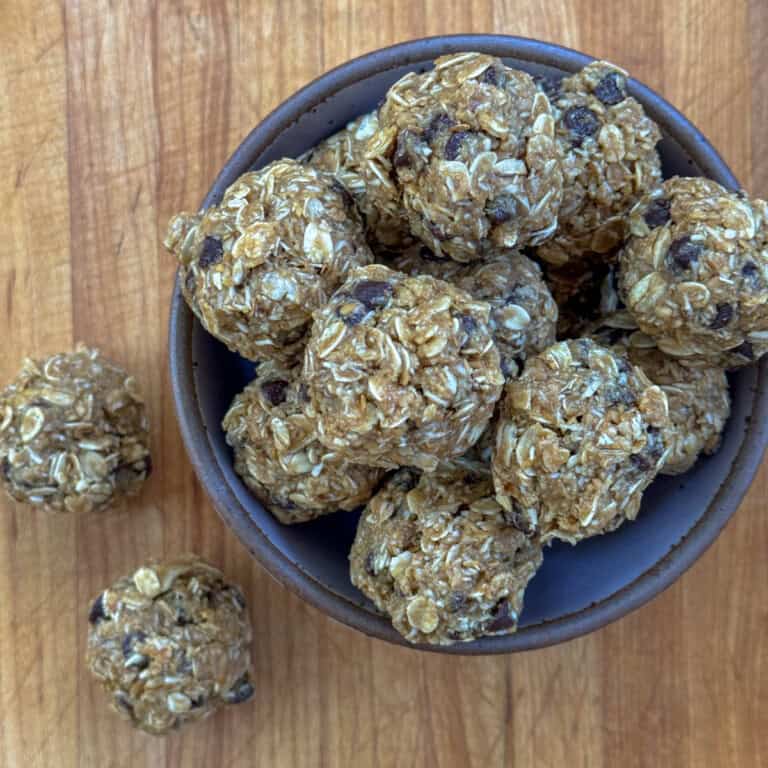There is so much nutrition information out there about what is “good” or “bad” for us to eat. There is also a lot of pressure on parents and teachers about teaching food and nutrition.
Eating well is a developmental task, a part of learning independence, but most parents know first hand just telling a child to eat something because of the nutrients it contains doesn’t “work.”

Young children are concrete thinkers
Children do not develop abstract thinking until age 12-13 or so.1 The science of nutrition is complex and abstract. We cannot simplify nutrition information into concrete sound bites, such as “protein makes you strong!” in order to teaching kids nutrition.
If we try, these sound bites can be interpreted in harmful ways. What is “healthy” for one person, may be an “unhealthy” choice for another.
The nutrients in food are important, but so is eating enough, how we think and feel about food, the connections we make with others over food, food accessibility, family traditions, and our genetics and specific health conditions.
We have lots of resources about how to teach kids nutrition in a developmentally appropriate way:
- Nutrition Education for Kids
- 5 Anti-Diet Resources to Give Teachers and Schools
- A School Lesson: The Edible Parts of a Plant
- Teaching Children Nutrition – What’s In Season?
- We also do a deeper dive in our membership: Take the Frenzy Out of Feeding.
“Eat your carrots, they help you see!”
There’s popular advice out there that we should teach young children what the nutrients in foods do for their bodies as a way to encourage them to eat fruits and vegetables. We couldn’t disagree more.
When we tie nutrition to specific health outcomes to young children, we can contribute to them feeling worried and anxious about food. While vitamin A (found in carrots and other orange foods) is essential for eye health, it doesn’t mean that our eyesight will be affected if we don’t eat carrots. As a young child, Elizabeth herself worried about eating enough carrots so she wouldn’t harm her own eyesight.

Young, concrete thinkers take our well intentioned advice of “protein makes you strong” or “cake is bad for you” and interpret it, well, concretely. As adults, we understand the complexity and abstract concepts of food and nutrition. We can understand that cake isn’t packed with as many vitamins and minerals as other foods, like say farro, or broccoli, but that doesn’t mean its “bad” or we should never eat cake.
A concrete thinker may feel confused as to why they are being told “cake is bad for you” and being served cake by their parent who is in charge of taking care of them. And young children may feel shame and confusion because they like cake and wonder if that makes them bad. Just like any food, cake can be part of healthy eating.

How to teach kids about nutrition
It’s best for us to teach children about nutrition in the same way we teach them other topics; in a developmentally appropriate way. We are advised as parents and teachers to teach children through modeling and hands-on experiences.
Nutrition is no different!
Teaching Food and Nutrition:
- Teach young children about where food comes from, how it grows or how is it made.
- Encourage curiosity. Ask children to notice what food looks, smells, feels, sounds and tastes like.
- Give children opportunities to interact with and be exposed to different foods. Offer a variety of foods at meal and snack times and during learning experiences when there is less pressure to eat the food.
- Teach children basic food cooking and preparation skills. Food preparation is a wonderful way to expose children to foods in a low pressure way.
- Read picture books about foods, especially those of different cultures. Highlight your own family’s culture and food traditions.
Telling a child they “should” eat something doesn’t lead to them eating that food.2 However, neutral exposure to foods does.
Nutrition lessons for children
Are you looking for ideas on how to teach kids nutrition? We have a 100+ page educator workbook with over 25 lessons. This workbook is for educators, parents, or health professionals interested in teaching preschool through elementary school all about food and nutrition in a developmentally appropriate way.
Be sure to keep an eye out for next week’s blog post that will feature more specific ideas for teaching nutrition to kids.
References:
- Piaget, J. (1977). The Development of Thought Equilibrium of Cognitive Structures. VikingPress.
- Scaglioni S, De Cosmi V, Ciappolino V, Parazzini F, Brambilla P, Agostoni C. Factors Influencing Children’s Eating Behaviours. Nutrients. 2018 May 31;10(6):706. doi: 10.3390/nu10060706. PMID: 29857549; PMCID: PMC602459





